From Gutters to Foundations: How Cold Weather Weakens Homes

That first cold snap of the season might feel refreshing after a long summer, but fall and winter can stress your home's critical systems. Without preventive maintenance, the cost of repairing damages from these sometimes extreme temperatures and weather events (like blizzards) can add up fast.
Our Winter Home Damage Survey echoes this, with 69% of U.S. homeowners reporting home damage due to winter weather. On top of this trend, data from the National Centers for Environmental Information (NCEI) shows winter property damage isn’t just limited to northern states—southern regions also face serious risks.
For example, the January 2024 winter storm struck states from Illinois down to Texas, causing $1.9 billion in damage. This event brought freezing temperatures, sleet, and high winds that damaged homes, vehicles, and businesses across the region.
The time to prepare for these weather events isn't when the forecast calls for the first freeze. Taking action now, before the temperature drops, could give you more control over how well your home’s critical systems handle cold weather.
Freeze-thaw cycles could damage your home
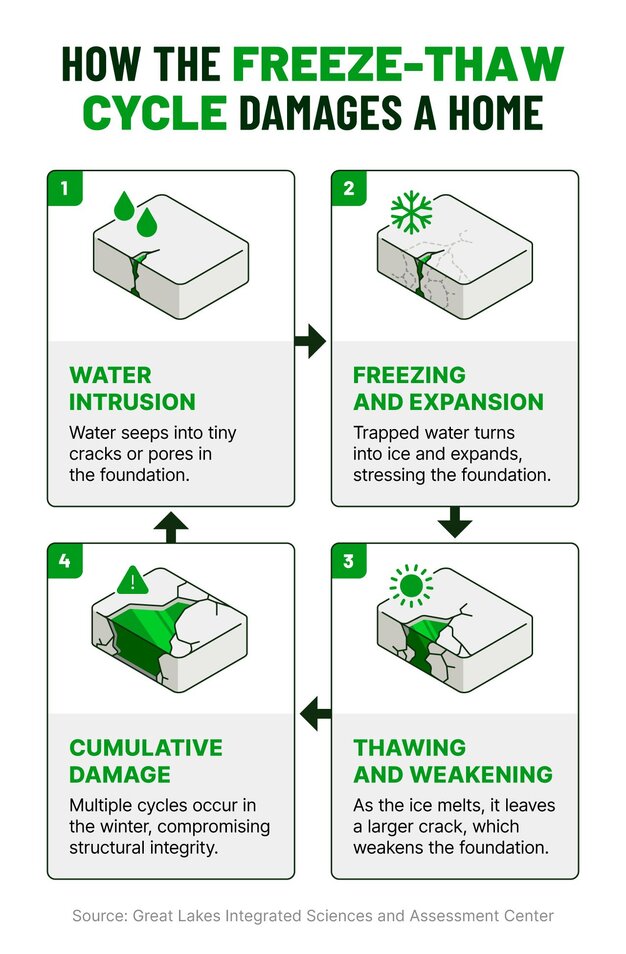
While it's tempting to push seasonal maintenance to the bottom of your to-do list, overlooking those tasks can lead to costly issues. As Bill Scott, General Manager at Smart Climate Solutions, explains, "Most homeowners skip our recommended twice-yearly maintenance visits, but then panic-call for emergency repairs during Pittsburgh's brutal winters."
Scott continues, "We see this constantly: A customer ignores fall maintenance to save $150, then faces a $3,000 emergency repair on Christmas Eve when their neglected system finally fails during a cold snap."
Cold-weather risks are real and can be costly. Prioritizing seasonal maintenance and understanding the risk of potential issues could help you avoid expensive damage.
Water’s impact on foundations and concrete
Concrete can absorb moisture during the wet fall and early winter seasons. Once that moisture freezes, the pressure from expanding ice can widen existing cracks or create new ones. This is common in driveways, sidewalks, and home foundations.2
Foundation repair costs vary widely, but homeowners could expect to pay anywhere from $250 to over $15,000. This depends on the extent of the damage and whether there are structural issues.
Addressing small issues early could be a more cost-effective way to protect your home.
These are general homeowner practices, not professional recommendations.
Proactive tips for homeowners:
- Look for cracks in concrete surfaces before winter starts, especially around your foundation or driveway.
- Watch for pooling water near the base of your home after it rains or snows. This can signal poor drainage that could lead to foundation damage.
- Keep an eye out for new gaps between walls and floors or doors that suddenly stick. This could signal a shifting foundation.
- Review your home insurance policy or speak with your licensed insurance producer for details on your foundation coverage. It may only cover damage from sudden events, excluding issues from neglect or a lack of maintenance.
Roof leaks and damage
Roofs can take a beating during cold weather. Freezing temps make shingles brittle, making them more likely to crack or break in strong winds or ice. Sealants around vents and chimneys can also wear out, creating openings where water can sneak in and cause roof leaks.3
Repairs for roof damage caused by cold weather can range from minor patchwork to full roof replacements.
HomeGuide reports that the cost to fix roof damage can range dramatically, from $150 to $1,000 for minor repairs and $3,000 to $6,000 or more for major issues.
Proactive tips for homeowners:
- Check your attic before and after storms for any signs of water leaks or drafts.
- Schedule a roof inspection before winter starts.
- Replace old caulk around chimneys or roof vents..
- Coverage for roof replacements or roof leaks varies by policy. Check your policy or consult your licensed insurance producer for guidance on how your coverage applies. Because some policies only cover severe weather when it’s specifically listed, it's important to know exactly what your home insurance includes.
Rain, snow, and ice damage to drainage
When water hits your roof, it needs a clear path to flow away from your home's structure. Without proper drainage, this moisture can get into your home.
This is especially true in states that see heavy snowfall, like Vermont, Maine, and New Hampshire, which can see average snowfall between 71.4 and 89.3 inches each year.4
Poor drainage can weaken your home’s structure over multiple freeze-thaw cycles. Water that pools around your foundation or sits in gutters can freeze, expand, and create openings for even more moisture to enter.
Issues with pipes and plumbing
When temperatures drop below freezing, water inside pipes expands, creating pressure that can cause cracks or bursts. This damage often happens in unheated areas like basements, crawl spaces, and exterior walls where pipes have less insulation.
According to Consumer Affairs, the average cost to repair a burst pipe is around $500. Addressing more serious issues, like substantial water damage from a single burst pipe, may cost more than $5,000.5
Proactive tips for homeowners: 6, 7
- Disconnect and drain outdoor plumbing fixtures before winter to help prevent water from freezing inside the lines and damaging interior plumbing connections.
- To prevent water from freezing, wrap pipes in colder areas of the home, like basements or attics, with foam insulation.
- Know where your main water shut-off valve is located in case pipes burst. This can help limit damage to your home.
- Allow faucets to drip slightly during extreme cold to keep water moving through pipes to prevent freezing.
Ice dams could cause damage, mold, or rot
Ice dams can form when poor attic insulation and ventilation allow heat to escape through your roof, melting snow unevenly. As melted snow flows down to the cooler roof edge, it refreezes and creates a dam of ice. This clog can stop water from draining, causing it to build up under shingles and possibly leak into your house.8
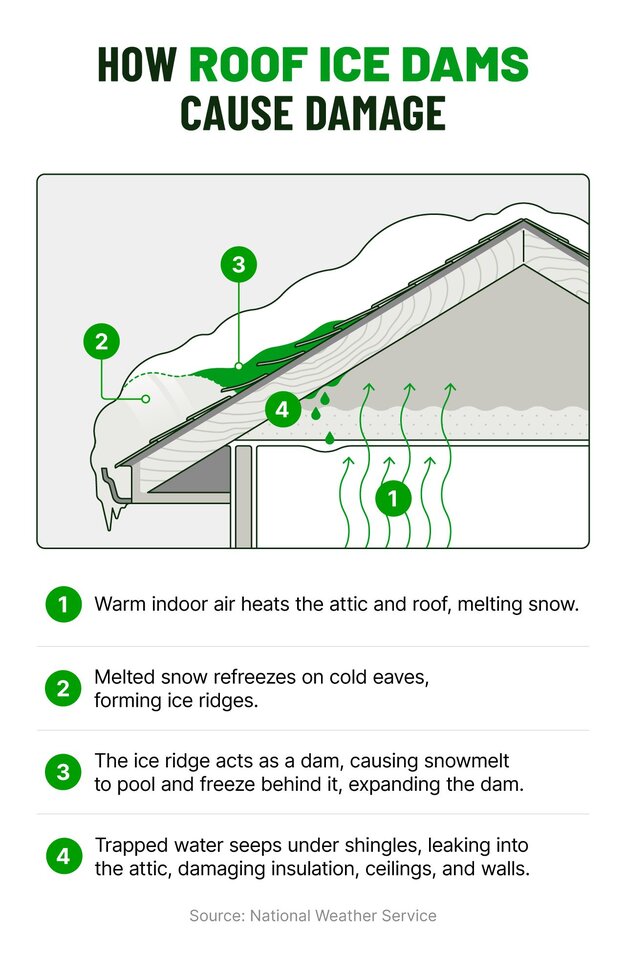
Ice dams can damage more than shingles. Once moisture gets inside the roof, it can cause wood rot and air quality issues in your home.8
Roofing expert Gerard Stencel, owner of Amsterdam Enterprises in Illinois, notes, "I've seen countless cases where [ice dams and] inadequate roof ventilation creates moisture buildup that rots sheathing and framing over multiple seasons… we're finding structural damage that took years to develop."
Ice dam removal can cost between $600 and $1,800, depending on the issue's severity and your home's size. Water damage repairs and mold remediation can cost thousands of dollars more.
Proactive tips for homeowners:
- Seal any gaps inside the attic around heating ducts, electrical wires, and pipes.
- If needed, install a ridge vent system or smaller vents in your soffits or gables to improve roof air circulation. Proper ventilation can help keep the roof deck cool, which can stop snow from melting and re-freezing into ice.
- Inspect your home’s exterior for potential heat leaks, such as small cracks or gaps around windows or doors.
- Make sure any kitchen, bathroom, or dryer vents are not directing warm air into the soffits, which can cause temperature fluctuations.
- Cap any roof access hatches to help prevent heat loss.
High winter winds and home damage
Tree branches and shingles, for example, can become more prone to snapping or cracking under cold wind stress.
Weakened trees and branches near the home
Without leaves to distribute wind stress, bare branches bear the full force of gusts, making them more likely to break. Dead or diseased branches that survived summer storms can fall due to harsh winter winds or snow and ice accumulation.9
When branches or entire trees fall due to cold weather (sometimes onto homes, vehicles, or power lines), their removal can cost a lot more than preventive trimming.
Emergency tree removal can cost an average of $1,000 to $2,500, while roof repairs from falling branches add to that cost. This doesn't include the cost of repairing or replacing damaged property.
Proactive tips for homeowners:
- Trim your trees so they’re not hanging over your home or vehicles.
- Check your trees for any new cracks, splits, or hanging branches.
- Pay close attention to branches that overhang your roof, power lines, or driveway. If they fall, they are most likely to cause damage or create a hazard.
Roof damage from strong, cold winds
Strong winds can loosen the metal strips (called flashing) around chimneys, vents, and other roof openings. When these protective seals get damaged, water can leak into the home.10
Wind and moisture can create a destructive cycle that could escalate to major roofing replacement projects. Minor damage to roofing materials typically costs $150 to $1,000 to repair, but extensive damage requiring partial or complete roof replacement can reach $16,000 or more.
The age and condition of your existing roof can have a big impact on both risk to wind damage and repair costs when damage occurs.
Proactive tips for homeowners:10
- Schedule a roof inspection to identify risks. An inspector can also recommend repairs.
- Check the metal flashing around chimneys, vents, and skylights to make sure it hasn't pulled away from the roof.
- Look for any loose, cracked, or missing shingles. Pay close attention to the edges of the roof and the ridge line, as these areas are most at risk of wind uplift.
- Coverage for wind damage and roof replacement can vary by policy. Review your policy or speak with your licensed insurance producer to understand how it applies. Some policies may include specific exclusions or deductibles for certain types of damage.
Cold weather and increased fire risks
Nearly half (46%) of all U.S. home heating equipment fires occur between December and February, according to the National Fire Protection Association (NFPA). Cold weather forces heating systems to work harder and longer than during any other season, increasing the likelihood of equipment malfunction or overheating.
Holiday traditions can also introduce fire hazards through increased cooking, decorative lighting, and the use of candles or fireplaces.
Heating and electrical system overload
Multiple heating devices, holiday lights, and seasonal appliances strain circuits beyond their capacity. This can create heat and ignite surrounding materials.
The U.S. Consumer Product Safety Commission emphasizes the dangers of winter fires. They report that heaters alone cause roughly 1,700 fires annually, while furnaces and fireplaces cause an average of 15,800 fires per year. Fortunately, there are a few things homeowners can do to help avoid these issues:
Proactive tips for homeowners: 11, 12
- Keep space heaters on a stable, flat surface. Keep them away from anything flammable, like curtains, bedding, or furniture.
- Plugging several high-wattage appliances into a single outlet or extension cord can overload the circuit and cause overheating, increasing the risk of a fire. If possible, use a separate outlet for each appliance.
- Regularly test your smoke and carbon monoxide detectors and replace their batteries.
- Review your insurance coverage or speak with your licensed insurance producer to find out what is and isn’t covered by your fire insurance policy.
Holiday decorations, cooking, and lighting
Holiday celebrations could bring fire hazards due to faulty electrical connections, overloaded circuits, and the closeness of flammable decorations to heat sources. For example, candles near decorations or wrapping paper can ignite, causing a fire.
Christmas trees present particular dangers as they dry out throughout the holiday season. A dry tree can become engulfed in flames within seconds, creating a flashover condition that gives occupants little time to escape. These fires alone can cause $15 million in property damage each year.
Proactive tips for homeowners: 13
- Inspect hanging lights for frayed wires, cracked sockets, or loose connections. Throw away any damaged strands.
- Water a real Christmas tree every day. A dry tree is very flammable.
- Don't connect too many strands of lights or decorations to one outlet. If you need to plug in several items, consider using a power strip with a surge protector.
- Always turn off all your holiday lights, both inside and outside, before you go to sleep or leave your home.
Proactive home protection for the colder months
While it can't prevent every issue, preparing your home ahead of fall and winter could help protect your home from seasonal damage. Check out our Fall Home Maintenance Checklist and Winter Home Maintenance Checklist to help you get started.
The free Hippo Home app also adds an extra layer of protection, providing routine maintenance reminders and expert tips.
Sources:
- Freeze-Thaw Cycles | GLISA
- The Freeze-Thaw Cycle in Concrete and Brick Assemblies | National Institutes of Health
- How the Freeze-Thaw Cycle Can Affect Your Roof | GAF
- Snowiest States 2025 | World Population View
- How Much Does It Cost to Repair Frozen Pipes? | Consumer Affairs
- Prepare Your Home Ahead of the Winter Season | Insurance Institute for Business and Home Safety
- How to Prevent Your Pipes From Freezing and Bursting | Consumer Reports
- Dealing with and preventing ice dams | University of Minnesota Extension
- 5 weather threats to be wary of during the fall | AccuWeather
- 5 Signs Of Wind Damage To Roof | Kraft Roofing
- NFPA shares information on U.S. home heating fires, which peak during winter months | Fire Chiefs Association of Massachusetts
- CPSC Warns Consumers to be Cautious When Using Space Heaters, Furnaces and Fireplaces This Winter | United States Consumer Product Safety Commission
- 10 Holiday Safety Tips | American Red Cross
- All quotes sourced from Featured.com.
Information sourced from publicly available sources as of September 2025.
This article is for informational purposes only and was compiled from sources not affiliated with Hippo. While we believe this information to be reliable, we do not guarantee its accuracy or completeness. The maintenance tips provided reflect general homeowner guidelines and are not professional advice. For any insurance-related decision, please consult your licensed insurance producer.
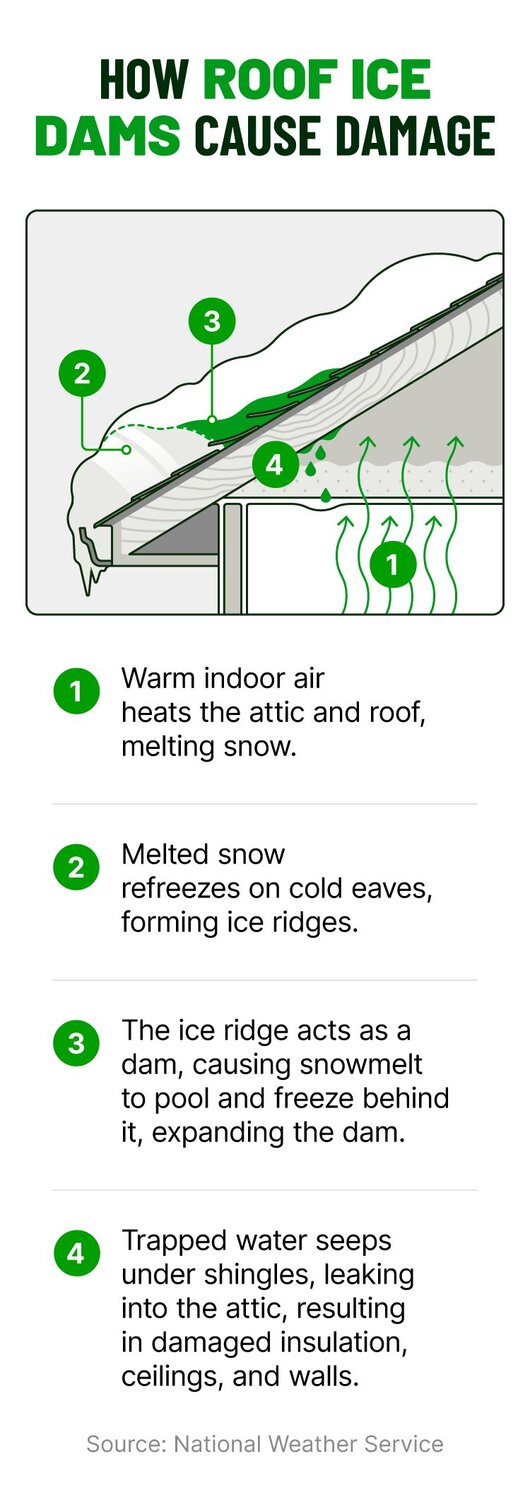

Related Articles
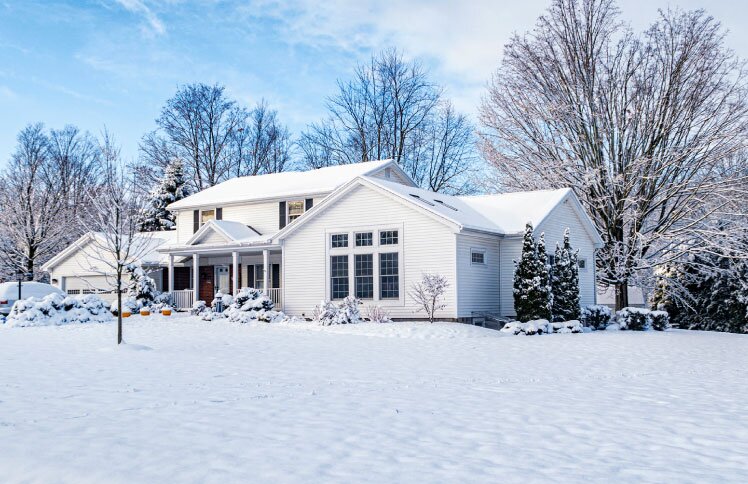
Battling the Elements: 69% of US Homes Damaged by Winter Storms

12 Winter Energy-Saving Tips For a Cozy and Efficient Home

6 Homeownership Tips for Snowbirds
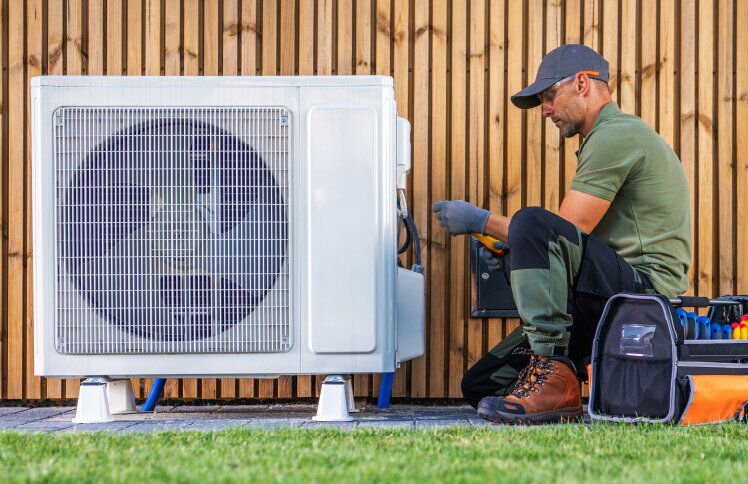
The 9 Most Expensive Home Repairs to Watch Out for in 2025
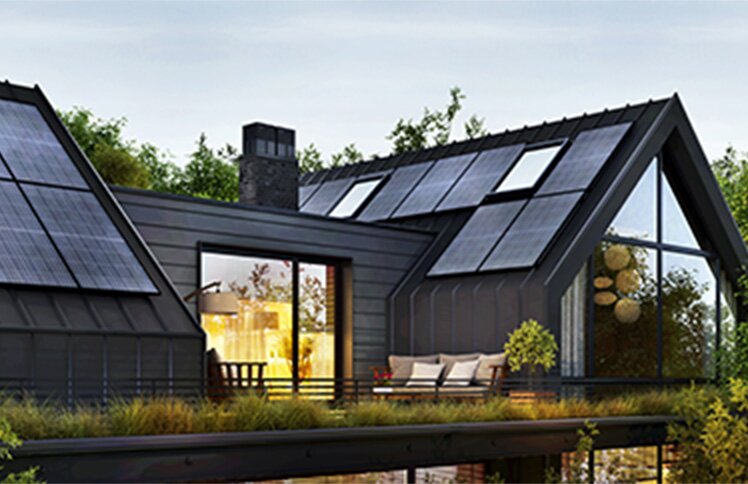
Homebuyers Want Disaster-Resilient Homes and 88% Will Pay More for Them

